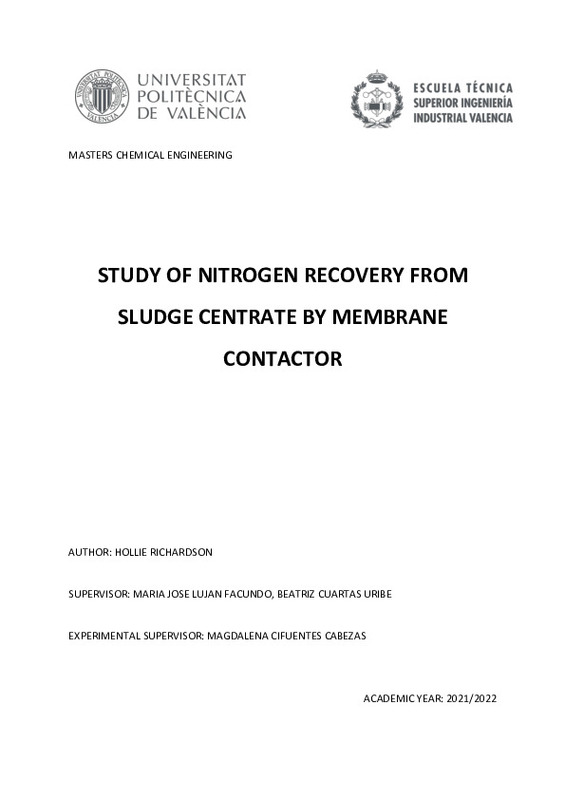JavaScript is disabled for your browser. Some features of this site may not work without it.
Buscar en RiuNet
Listar
Mi cuenta
Estadísticas
Ayuda RiuNet
Admin. UPV
Study of nitrogen recovery from sludge centrate by means of membrane contactor
Mostrar el registro sencillo del ítem
Ficheros en el ítem
| dc.contributor.advisor | Luján Facundo, María José
|
es_ES |
| dc.contributor.advisor | Cuartas Uribe, Beatriz Elena
|
es_ES |
| dc.contributor.advisor | Cifuentes Cabezas, Magdalena Soledad
|
es_ES |
| dc.contributor.author | Richardson, Hollie
|
es_ES |
| dc.date.accessioned | 2022-06-09T07:34:13Z | |
| dc.date.available | 2022-06-09T07:34:13Z | |
| dc.date.created | 2022-05-24 | |
| dc.date.issued | 2022-06-09 | es_ES |
| dc.identifier.uri | http://hdl.handle.net/10251/183147 | |
| dc.description.abstract | [ES] El fango generado en las estaciones depuradoras de aguas residuales urbanas es comunmente tratado a través de una digestión anaerobia. La fracción líquida obtenida en este proceso se suele devolver a cabecera de planta, sin embargo, el alto contenido en nutrientes que esta corriente posee la convierte en un residuo de alto valor añadido. Así pues, la recuperación de nutrientes de esta corriente puede ser una excelente oportunidad para la fabricación de fertilizantes. El principal objetivo de este trabajo es, a partir de una disolución sintética de escurrido de centrífuga, estudiar la recuperación de nitrógeno amoniacal empleando un contactor de membrana. Dicho sistema contiene una membrana hidrofóbica de polipropileno. Además, se estudiará la influencia de la presencia de materia orgánica e iones en el agua a tratar, la temperatura de ésta y la concentración de ácido empleado en la disolución de arrastre. | es_ES |
| dc.description.abstract | [EN] This final masters’ project was carried out at the Universitat Politècnica de València (UPV) under the Membrane Processes, Liquid Effluent Treatment and Optimization (PROMETEO) research group. The main objective of the project was to separate ammonium nitrogen (NH4 + ) from sludge centrate by a membrane contactor and establish the optimal operating conditions. The demand for NH4 + is always increasing due to its important applications within the fertiliser industry. With the current production method being very environmentally damaging, a sustainable alternative must be found. Currently, the sludge centrate is recirculated back to the head of the wastewater treatment plant (WWTP) but targeting this for NH4 + recovery provides a sustainable source and adds a profitable product rather than treatment. Sludge undergoes treatment within the WWTP until the final by-product of sludge centrate is produced, which contains a high concentration of ammoniacal nitrogen (ammonia and ammonium). Therefore, by using a hollow fibre liquid-liquid membrane contactor (HF-LLMC), the NH4 + can be recovered from the sludge centrate. Sulphuric acid was used to strip the NH4 + from the sludge centrate, which resulted in the production of ammonium sulphate – a saleable product. The experiments were set up using a commercial HF-LLMC (Liqui-Cel EXF – 2.5x8 Series (3M, USA)) in a closed-loop pilot plant. The parameters studied were feed solution temperature, stripping solution concentration and wastewater composition. Feed solutions were passed through the shell side of the HF-LLMC whereas the stripping solution was passed through the lumen side, both at a constant flow rate of 30 L/h. Samples were taken throughout and analysed to determine the concentration of NH4 + and other substances present in the feed solution at the end of the experiment. From this, the removal efficiencies were calculated to draw conclusions of the feasibility of the HF-LLMC. The analysis of the results showed the HF-LLMC to be a suitable alternative for the recovery of NH4 + . On average, 66.36% of NH4 + was removed from the sludge centrate with the highest removal being 71.52%. This occurred at a feed temperature of 35 o C, a stripping concentration of 0.1 M and a wastewater composition comprising of NH4Cl, organic matter and ions. It was shown that the feed temperature and stripping concentration directly influenced the NH4 + removal efficiency, whereas the feed composition didn’t. Recommendations for this study would be to collect further experimental data with different parameters to achieve a better overview of the optimal conditions for the NH4 + removal. The project overall showed promising results and great potential towards future research of the HF-LLMC and integrating this technology in a WWTP for nitrogen recovery from sludge centrate. | es_ES |
| dc.format.extent | 50 | es_ES |
| dc.language | Inglés | es_ES |
| dc.publisher | Universitat Politècnica de València | es_ES |
| dc.rights | Reserva de todos los derechos | es_ES |
| dc.subject | Escurrido de centrífuga | es_ES |
| dc.subject | Nutrientes | es_ES |
| dc.subject | Nitrógeno amoniacal | es_ES |
| dc.subject | Contactores de membrana | es_ES |
| dc.subject.classification | INGENIERIA QUIMICA | es_ES |
| dc.subject.other | Máster Universitario en Ingeniería Química-Màster Universitari en Enginyeria Química | es_ES |
| dc.title | Study of nitrogen recovery from sludge centrate by means of membrane contactor | es_ES |
| dc.title.alternative | Recuperación de nitrógeno amoniacal del escurrido de centrífuga mediante contactores de membrana | es_ES |
| dc.title.alternative | Estudi de la recuperació de nitrogen amoniacal de l'escorregut de centrífuga mitjanÇant contactors de membrana | es_ES |
| dc.type | Tesis de máster | es_ES |
| dc.rights.accessRights | Abierto | es_ES |
| dc.contributor.affiliation | Universitat Politècnica de València. Departamento de Ingeniería Química y Nuclear - Departament d'Enginyeria Química i Nuclear | es_ES |
| dc.contributor.affiliation | Universitat Politècnica de València. Escuela Técnica Superior de Ingenieros Industriales - Escola Tècnica Superior d'Enginyers Industrials | es_ES |
| dc.description.bibliographicCitation | Richardson, H. (2022). Study of nitrogen recovery from sludge centrate by means of membrane contactor. Universitat Politècnica de València. http://hdl.handle.net/10251/183147 | es_ES |
| dc.description.accrualMethod | TFGM | es_ES |
| dc.relation.pasarela | TFGM\148668 | es_ES |
Este ítem aparece en la(s) siguiente(s) colección(ones)
-
ETSII - Trabajos académicos [9864]
Escuela Técnica Superior de Ingenieros Industriales






